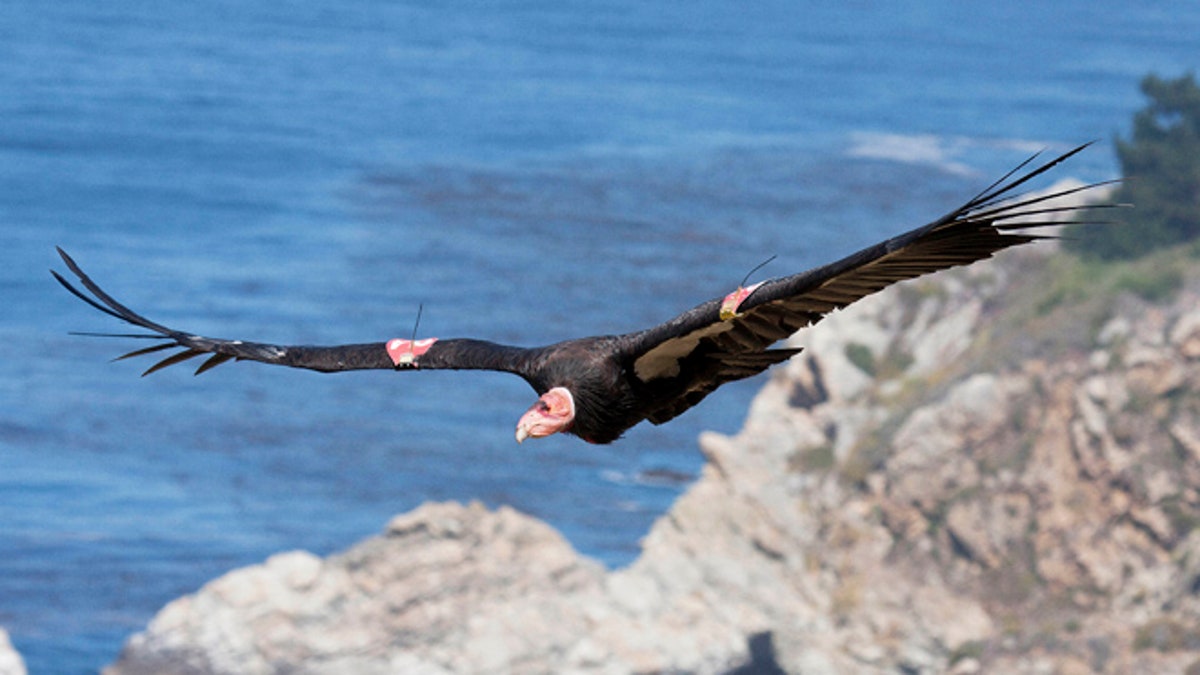
July 21, 2012: This file photo provided by the Ventana Wildlife Society shows a condor in flight in Big Sur, Calif. (AP/Ventana Wildlife Society)
Yurok tribal tradition holds the California condor as sacred, with ancient stories saying the giant birds fly closest to the sun and are the best messengers to carry prayers.
Now, after five years of research, the far northern California-based tribe has received permission to release captive-bred condors into the Redwood Coast, where the giant bird hasn't soared for more than a century.
Yurok officials signed a memorandum of understanding last month with state and federal agencies and a condor conservation group, allowing for test releases as a final assessment of whether the region can support the endangered birds.
The first releases could come in the next one to three years, tribal biologist Chris West said. Meetings will begin in July to work out protocols and select a release site.
Seven sites are under consideration on Redwood National and State Parks and private land within about 50 miles of each other, primarily south of the Klamath River.
With federal funding in short supply, the tribes will work to develop private funding to cover the estimated annual cost of about $400,000, West said.
The return of the condor is part of Yurok environmental work, along with efforts to restore salmon numbers and improve forest health.
Condor feathers are part of traditional regalia used in ceremonial dances, said tribal microbiologist Tiana Williams. With no condors flying over tribal lands, there are no new feathers to replace old plumes worn out from use.
"When a species like condor or eagle gives you material for your regalia, it is considered their spirit is in that, too. They are singing with you, and praying with you," she said. "We can get feathers from the U.S. Fish and Wildlife Service, but it's not the same thing as being able to go out there and collect the feathers we need from condors flying over our own skies."
For Fish and Wildlife, establishing another population of condors far from the five existing sites in Southern and central California, Arizona, and Mexico's Baja California would reduce the risks associated with the giant bird's recovery.
Condors once flew the Pacific Coast from Mexico to Canada. There are just over 400 California condors in the world now, and only about 230 in the wild, said John McCamman, condor coordinator for Fish and Wildlife in Sacramento, Calif. That's up from just 22 birds in 1982, he said.
Condors face threats to their recovery, the top danger being ingesting lead shot or bullet fragments in an animal carcass, McCamman said.
West would like to see a new format for releasing birds, starting with a pair of mature adults, and gradually adding younger birds for a total of six.
All the birds would be fitted with tiny radio transmitters on their wings and tails, allowing biologists in the field to track them, and some with GPS satellite trackers, which send a position to a biologist's desk computer. That makes monitoring for lead poisoning easier.
Using $600,000 in grants from Fish and Wildlife, the tribe has been assessing habitat, taking blood samples from turkey vultures to assess the threat of lead poisoning and testing dead sea lions that wash up on the beach for DDT.
The lead levels in the vultures were lower than anywhere else in the condor's range, West said.
DDT contamination has also been lower than elsewhere.
Like eagles, condors in the 1960s and 1970s became unable to hatch their eggs because DDT made the shells too thin.
To provide the greatest genetic diversity possible, birds would come from breeding programs in Oregon, Idaho and California, and all the release sites, McCamman said.
The Fish and Wildlife Service, the National Park Service, the California Department of Parks and Recreation, and the Ventana Wildlife Society all signed the memorandum.
